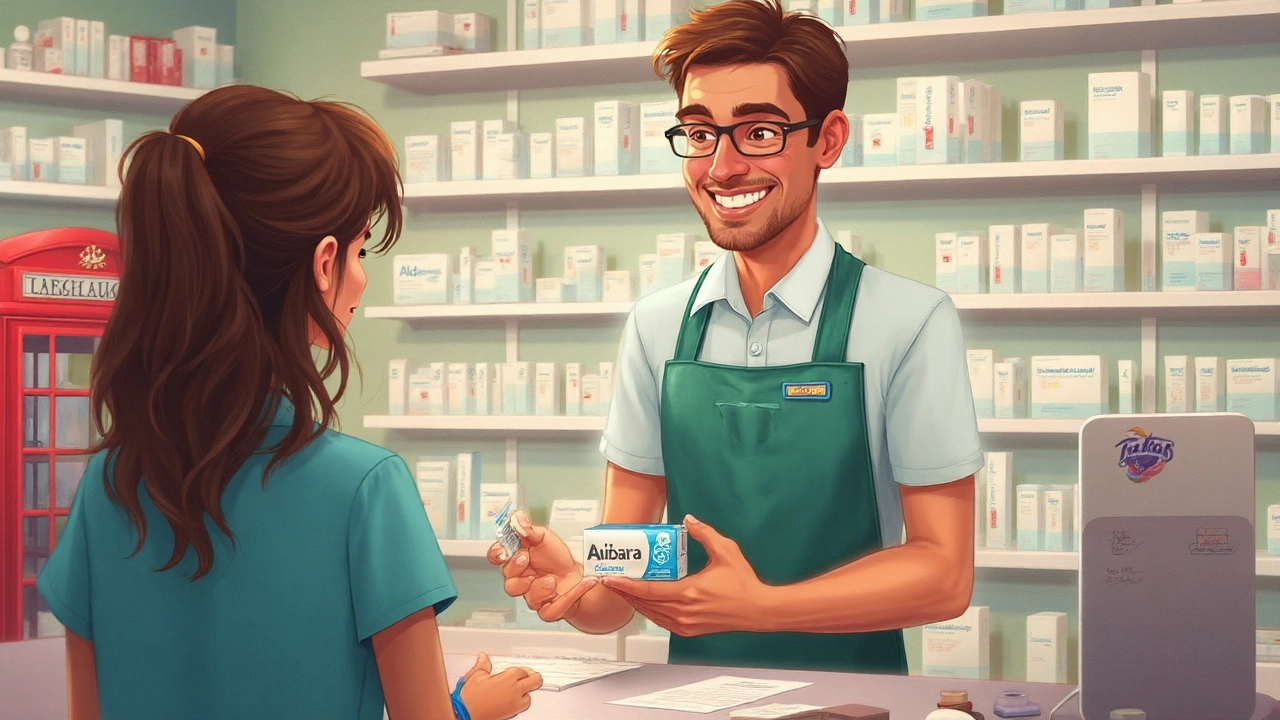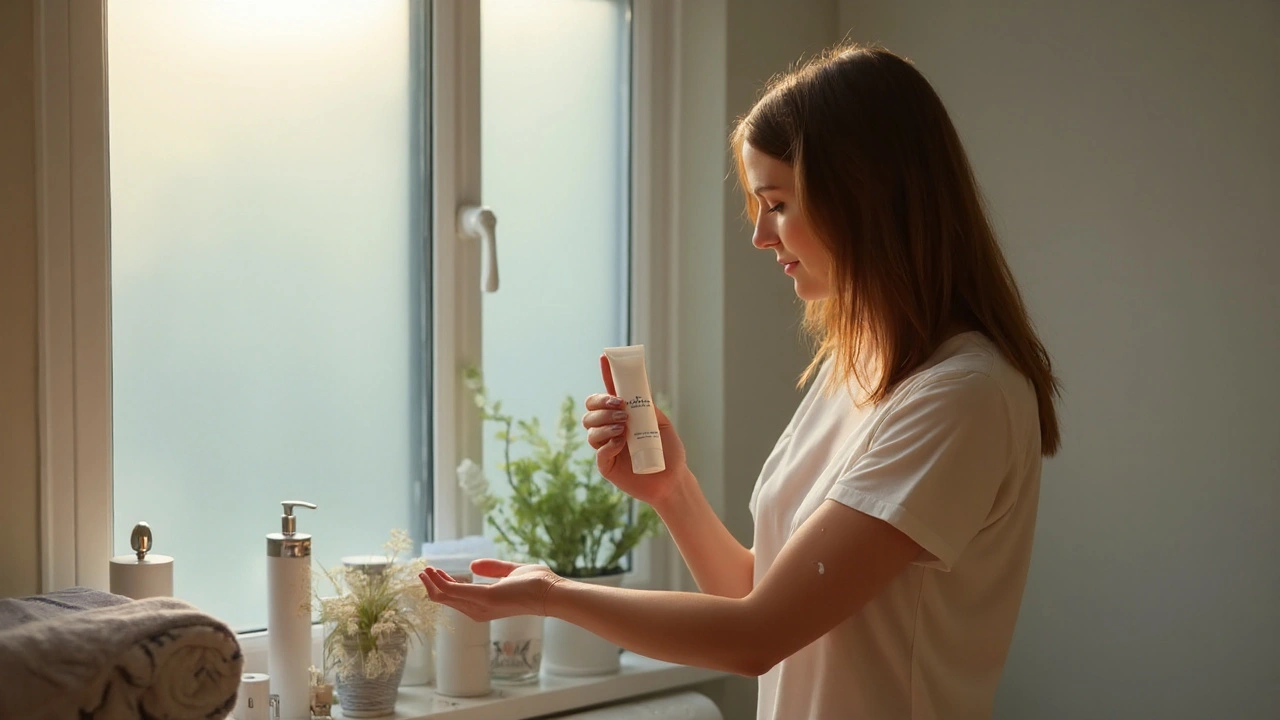TL;DR
- Aldara Cream (imiquimod) is a prescription topical immune‑activator for actinic keratosis, genital warts and superficial basal cell carcinoma.
- Apply a thin layer once daily, usually at bedtime, for 2‑16 weeks depending on the condition.
- Common reactions - redness, crusting, itching - are normal; stop use and contact a doctor if severe swelling or fever occurs.
- Cost in Australia ranges $50‑$80 per 5‑g tube; many health funds subsidise it for qualifying skin lesions.
- Alternatives include 5‑fluorouracil cream and photodynamic therapy; choose based on lesion type, tolerance and doctor advice.
What is Aldara Cream and How Does It Work?
Aldara Cream, whose active ingredient is imiquimod, isn’t a traditional antibiotic or steroid. Instead, it tricks the body’s own immune system into thinking there’s a viral infection on the skin. This triggers a cascade of cytokines-mainly interferon‑alpha, tumour‑necrosis factor‑α and interleukins-that recruit white‑blood cells to the treated area.
The result is two‑fold: abnormal skin cells (like those in actinic keratosis or early basal cell carcinoma) are destroyed, and human papillomavirus‑induced warts are cleared as the immune system attacks the virus.
Regulatory agencies such as the TGA (Therapeutic Goods Administration) list three primary indications in Australia:
- Actinic keratosis (sun‑damaged skin patches that can turn cancerous).
- External genital and perianal warts caused by HPV.
- Superficial basal cell carcinoma (a low‑risk skin cancer).
Because it works by activating immunity rather than killing cells directly, treatment timelines can feel longer-often 4‑12 weeks of nightly application-yet the long‑term clearance rates are impressive: 80‑90% for genital warts and 70‑80% for actinic keratosis in clinical trials.
How to Use Aldara Cream Safely and Effectively
Applying Aldara correctly maximises benefits and keeps side‑effects manageable. Below is a step‑by‑step routine most dermatologists recommend.
- Get a prescription. In Australia, Aldara is Schedule4 (prescription‑only). Your doctor will confirm the diagnosis, assess lesion size and discuss any contraindications such as pregnancy or immune‑suppression.
- Clean the treatment area with mild soap and water. Pat dry-no lotions, oils or deodorants.
- Measure the exact amount. For most lesions, a pea‑sized dab (about 0.5g) spread as a thin, even layer is enough. Over‑application doesn’t speed healing; it just raises irritation risk.
- Apply once nightly, preferably before bedtime. Avoid using other skin products on the same spot for at least 12hours after application.
- Wash your hands thoroughly after each use to prevent accidental transfer to eyes or mucous membranes.
- Leave the cream on for the full night (≈6‑8hours). In the morning, gently wash the area with warm water and mild soap. Do not scrub.
- If you miss a night, skip the next scheduled dose and resume the regular schedule-don’t double‑dose.
- Track your progress. Most practitioners ask patients to bring photos at each follow‑up visit, noting any excessive redness, blistering or fever.
Typical treatment lengths vary:
- Genital warts: 2‑16 weeks, depending on response.
- Actinic keratosis: 2‑4 weeks of nightly use, then a 2‑week break.
- Superficial basal cell carcinoma: 4‑12 weeks, with the doctor monitoring for complete resolution.
Side‑effects are usually local and transient. Expect:
- Redness, swelling, itching, or a burning sensation.
- Crusting or flaking as the lesions slough off.
- Mild flu‑like symptoms (fever, headache) in about 5% of users-these signal a robust immune response.
If any of the following occur, pause treatment and call your dermatologist immediately:
- Severe swelling extending beyond the target area.
- Persistent fever (>38°C) lasting more than 24hours.
- Signs of secondary infection-pus, foul odor, rapidly spreading redness.
Pro‑tips to keep discomfort low:
- Start with a “test patch” on a small area for 48hours. If tolerance is good, expand to the full lesion.
- Apply a cool compress (a damp washcloth) for 5‑10minutes after washing in the morning if burning feels intense.
- Stay out of direct sunlight during treatment. UV exposure can amplify redness.

Choosing Aldara Cream: Cost, Availability, and Alternatives
When deciding whether Aldara is right for you, weigh three practical factors: price, prescribing logistics, and other treatment options.
| Factor | Aldara (Imiquimod 5%) | 5‑Fluorouracil Cream (5‑Fluorouracil) | Photodynamic Therapy (PDT) |
|---|---|---|---|
| Primary indication | Genital warts, actinic keratosis, superficial BCC | Actinic keratosis, superficial BCC | Actinic keratosis, early BCC (selected cases) |
| Application frequency | Once nightly | Twice daily for 2‑4weeks | 1‑2 clinic visits (light exposure) |
| Common side‑effects | Redness, crusting, flu‑like symptoms | Severe irritation, ulceration | Pain during light exposure, temporary discoloration |
| Cost in Australia (2025) | $55‑$80 per 5g tube (PBS subsidised for eligible patients) | $35‑$50 per 5g tube (no subsidy) | $300‑$500 per treatment session |
| Prescription requirement | Yes (Schedule4) | Yes (Schedule4) | Yes (procedure) |
In many cases, Aldara’s convenience-home use versus a clinic visit-makes it the first‑line choice for genital warts and small actinic patches. However, for patients who can’t tolerate inflammation, 5‑fluorouracil’s shorter course may be preferable, albeit with a higher irritation profile.
For those with extensive field‑cancerisation (many actinic lesions across a large area), dermatologists sometimes combine therapies: a short course of Aldara to clear warty lesions, followed by PDT to treat the surrounding sun‑damage.
Insurance and the Australian Pharmaceutical Benefits Scheme (PBS) often cover Aldara for listed conditions, but the patient usually pays a co‑pay of about $30‑$40 per prescription. If you’re uninsured, ask the pharmacy about bulk‑buy discounts or generic imiquimod equivalents that may be cheaper.
Mini‑FAQ - Your Most Common Aldara Questions Answered
- Can I use Aldara during pregnancy? No. Imiquimod is contraindicated in pregnancy because it could affect fetal immune development.
- How long does it take to see results? Most patients notice a reduction in wart size after 2‑3 weeks, but full clearance often requires the entire prescribed course.
- Is Aldara safe for children? It’s approved for use in children aged 12 and older for genital warts; younger children need specialist assessment.
- Will Aldara cause scarring? If applied correctly and the skin is allowed to heal, scarring is rare. Over‑scrubbing or picking at crusts can increase risk.
- Can I apply sunscreen over the treated area? Wait until the morning wash is complete and the skin is dry; then a broad‑spectrum SPF30+ sunscreen can protect against UV‑induced redness.

Next Steps and Troubleshooting
If you’ve decided to start Aldara, schedule a brief consultation with a dermatologist or GP to confirm the diagnosis and obtain the prescription. Keep the following checklist handy:
- Prescription details (strength, quantity, treatment length).
- Written after‑care instructions from your prescriber.
- A daily diary to note skin reaction, pain level, and any systemic symptoms.
- Contact information for your clinic’s after‑hours line.
Should you experience unexpected side‑effects, try these quick fixes before calling the doctor:
- Apply a cool compress for 10minutes to reduce burning.
- Switch to a fragrance‑free moisturizer on the surrounding skin (not on the treated spot) to lessen dryness.
- Shorten the application window: use the cream every other night for one week, then reassess.
Remember, the goal of Aldara isn’t a painless experience-it’s an immune boost that creates controlled inflammation. Staying within the prescribed schedule and monitoring your skin closely will give you the best chance of clearing the lesion without unnecessary discomfort.
Ready to talk to your doctor? Bring this guide, note any questions you have, and you’ll walk into the appointment feeling informed and confident.

Ram Dwivedi
Hey r/dermatology folks, I’ve been using Aldara for a while now and thought I’d share a quick rundown. The cream works by basically waving a flag that tells your immune cells “hey, there’s an invader here”, which then rallies cytokines to the spot. Because it’s not a steroid, you won’t see the classic soothing effect – instead you get a controlled burn that clears the lesion. Most people start with a pea‑sized dab and spread it thin, as the guide mentions. Consistency is key – try to apply it at night so you can wash it off in the morning without rushing. I found that using a cool compress after the morning wash really eases the sting. If you notice any crusting that looks like a scab, let it stay; don’t pick at it or you’ll risk scarring. A little bit of redness is totally normal, but if it spreads beyond the treatment area, get a call with your doc. Some users get mild flu‑like symptoms – think low‑grade fever or headache – that usually means the immune system is doing its job. For genital warts, the typical course is about 12 weeks, but you can stop early if you see complete clearance. In my experience with actinic keratoses, a 4‑week cycle plus a 2‑week break works great. The cost in Australia can be a bite, but many PBS schemes cover a chunk of it, so ask your pharmacist. If you’re looking for alternatives, 5‑fluorouracil is harsher and PDT is pricier but worth it for large field‑cancerisation. Always keep a diary of your skin’s response – a simple note each day helps the dermatologist adjust the plan. Remember, the goal isn’t painless, it’s targeted inflammation that pushes out the abnormal cells. Stay patient, stay moisturized (just not on the cream spot), and you’ll likely see those lesions fade away. 😄
pooja shukla
Aldara might be the go‑to in Aussie docs, but honestly we have better sun‑guards back home. The cream’s hype is just pharma marketing fluff. Use it if you must, but don’t forget sunscreen.
Poonam Mali
The immunomodulatory cascade invoked by imiquimod epitomizes a paradigm of cutaneous immune surveillance, wherein Toll‑like receptor activation precipitates a milieu of interferon‑α and TNF‑α. Such a pro‑inflammatory vector, albeit efficacious, engenders iatrogenic dermatitis if not meticulously titrated. Moreover, the ethical ramifications of inducing systemic flu‑like sequelae demand circumspect patient consent. Clinical outcomes, while statistically robust, must be weighed against the psychosocial burden of conspicuous erythema. Consequently, prescribers ought to implement a stratified risk‑benefit algorithm prior to initiation.
Alan Whittaker
What they don’t tell you is that the pharma lobby pushes Aldra to lock you into a chronic inflammation loop, feeding data back to their labs. The TGA’s “approval” is just a rubber‑stamp after heavy lobbying. It’s no coincidence that the same companies own the sunscreen brands you’re told to use after treatment. Keep your eyes open; every cream is a data‑harvesting vector.
Michael Waddington
Sounds painful.
HAMZA JAAN
I watched a friend wrestle with Aldara for months, and the emotional roller‑coaster was as intense as the skin reaction. The nightly routine turned into a ritual of hope and dread, each morning unveiling a new crust that felt like a badge of battle.
April Rios
If we consider the skin as a canvas of identity, then Aldara acts as a philosopher‑king, compelling the body to confront its hidden imperfections. The controlled inflammation mirrors the necessary struggle in life to achieve true clarity.
byron thierry
Dear colleagues, I would like to commend the comprehensive nature of this guide. It elucidates both pharmacodynamics and practical application with commendable clarity, thereby facilitating informed clinical decision‑making. Moreover, the inclusion of cost considerations is particularly beneficial for patient‑centred discussions.
bob zika
In addition, the table summarising cost versus alternative therapies, while succinct, provides an invaluable reference point, especially for practitioners aiming to balance efficacy, tolerability, and financial burden; consequently, it should be retained as a staple within dermatologic consults.
M Black
Yo guys Aldara is a beast but it works 😎 just slap it on at night keep it thin and you’ll see those warts disappear trust me
Sidney Wachira
The moment I opened the tube, I felt like I was holding a potion straight out of a medieval alchemist’s lab-its scent, its texture, the promise of battle against my stubborn lesions, all wrapped in a tiny 5‑gram vial!
Aditya Satria
Please note that the correct procedure is to apply a thin layer, not a thick coat, and to wash your hands thoroughly after use; this prevents inadvertent transfer to the eyes or mucous membranes, which could cause irritation.
Jocelyn Hansen
Hey team, great discussion here, keep sharing your experiences, it really helps newcomers navigate the treatment journey, and remember to be kind to yourselves during those tough weeks, you’ve got this!
Joanne Myers
The guide is thorough and practical
rahul s
Dude this Aldara stuff is like a fireworks show on your skin – bright, loud, and unforgettable, but you just gotta watch the sparkles or you’ll end up with a burnt canvas.
Julie Sook-Man Chan
I’ve found the test‑patch method works well to gauge tolerance before committing to full‑area application.
Amanda Mooney
In summary, adherence to prescribed intervals maximizes efficacy while minimizing adverse effects.